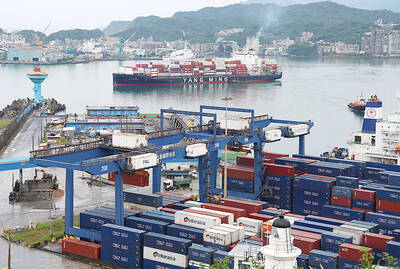The nation lags behind China in developing Internet banking because regulators are less tolerant of financial innovations that may upset the traditional banking ecosystem, Greg Gibb, chairman of the Shanghai Lujazui International Financial Asset Exchange Co, said yesterday.
Gibb, founder of Lufax.com, a peer-to-peer lending platform under China’s Ping An Group (中國平安), said the platform is the world’s third-largest P2P firm just two years after its formation, thanks to regulatory tolerance and the prevalence of the Internet and smartphones.
Peer-to-peer lending, also known as person-to-person lending and abbreviated to P2P lending, is the practice of lending money to unrelated individuals or peers without going through a traditional financial intermediary such as a bank.
Lending is transacted online on a host Web site using various lending platforms and credit checking tools. P2P lending is growing fast in many countries and China stays ahead in this market as the number of Internet users is increasing rapidly and regulatory restrictions are largely absent, said Gibb, who used to be chief operating officer at Taishin Financial Holding Co (台新金控).
There were 1,000 P2P companies in China as of last year with transactions totaling 105.8 billion yuan (US$17.03 billion), including 26.8 billion in deposits and 68.03 billion in loans, Gibb said.
Taiwan may not see a big breakthrough in the next three years as regulators are conservative about financial innovation, even though the government constantly underscores the importance of innovation, Gibb said, adding that the overcrowded and fragmented market helps limit bold and competitive strategies.
China allows non-traditional innovation and takes regulatory action only when necessary, he said.
That helps explain why China’s e-commerce agent Alibaba Group Holding Ltd (阿里巴巴) and its online payment affiliate, Alipay.com Co (支付寶) have expanded so fast, and risen to a globally dominant position, Gibb said.
“Greater market tolerance fosters better discipline among companies,” he said, whereas Taiwanese regulators have implemented detailed restrictions to slow e-commerce.
In addition, the large difference in interest margins between traditional banks and underground lenders provides business opportunities for P2P companies, Lufax.com vice president Hurbert Tai (戴修憲) said.
Chinese banks set interest rates at about 8 percent, but shadow banking firms may charge 30 percent to 40 percent.
Aware of the high credit risk linked to innovation, Gibb said he would not be surprised if 80 percent of P2P companies folded, as quite a few have exited the market, mainly because of reckless operations and loose credit analyses.
Lufax has managed to avoid the mistakes by using big data to analyze the credit profiles of potential clients, Gibb said.

CHIP RACE: Three years of overbroad export controls drove foreign competitors to pursue their own AI chips, and ‘cost US taxpayers billions of dollars,’ Nvidia said China has figured out the US strategy for allowing it to buy Nvidia Corp’s H200s and is rejecting the artificial intelligence (AI) chip in favor of domestically developed semiconductors, White House AI adviser David Sacks said, citing news reports. US President Donald Trump on Monday said that he would allow shipments of Nvidia’s H200 chips to China, part of an administration effort backed by Sacks to challenge Chinese tech champions such as Huawei Technologies Co (華為) by bringing US competition to their home market. On Friday, Sacks signaled that he was uncertain about whether that approach would work. “They’re rejecting our chips,” Sacks

Taiwan’s exports soared 56 percent year-on-year to an all-time high of US$64.05 billion last month, propelled by surging global demand for artificial intelligence (AI), high-performance computing and cloud service infrastructure, the Ministry of Finance said yesterday. Department of Statistics Director-General Beatrice Tsai (蔡美娜) called the figure an unexpected upside surprise, citing a wave of technology orders from overseas customers alongside the usual year-end shopping season for technology products. Growth is likely to remain strong this month, she said, projecting a 40 percent to 45 percent expansion on an annual basis. The outperformance could prompt the Directorate-General of Budget, Accounting and

NATIONAL SECURITY: Intel’s testing of ACM tools despite US government control ‘highlights egregious gaps in US technology protection policies,’ a former official said Chipmaker Intel Corp has tested chipmaking tools this year from a toolmaker with deep roots in China and two overseas units that were targeted by US sanctions, according to two sources with direct knowledge of the matter. Intel, which fended off calls for its CEO’s resignation from US President Donald Trump in August over his alleged ties to China, got the tools from ACM Research Inc, a Fremont, California-based producer of chipmaking equipment. Two of ACM’s units, based in Shanghai and South Korea, were among a number of firms barred last year from receiving US technology over claims they have

BARRIERS: Gudeng’s chairman said it was unlikely that the US could replicate Taiwan’s science parks in Arizona, given its strict immigration policies and cultural differences Gudeng Precision Industrial Co (家登), which supplies wafer pods to the world’s major semiconductor firms, yesterday said it is in no rush to set up production in the US due to high costs. The company supplies its customers through a warehouse in Arizona jointly operated by TSS Holdings Ltd (德鑫控股), a joint holding of Gudeng and 17 Taiwanese firms in the semiconductor supply chain, including specialty plastic compounds producer Nytex Composites Co (耐特) and automated material handling system supplier Symtek Automation Asia Co (迅得). While the company has long been exploring the feasibility of setting up production in the US to address